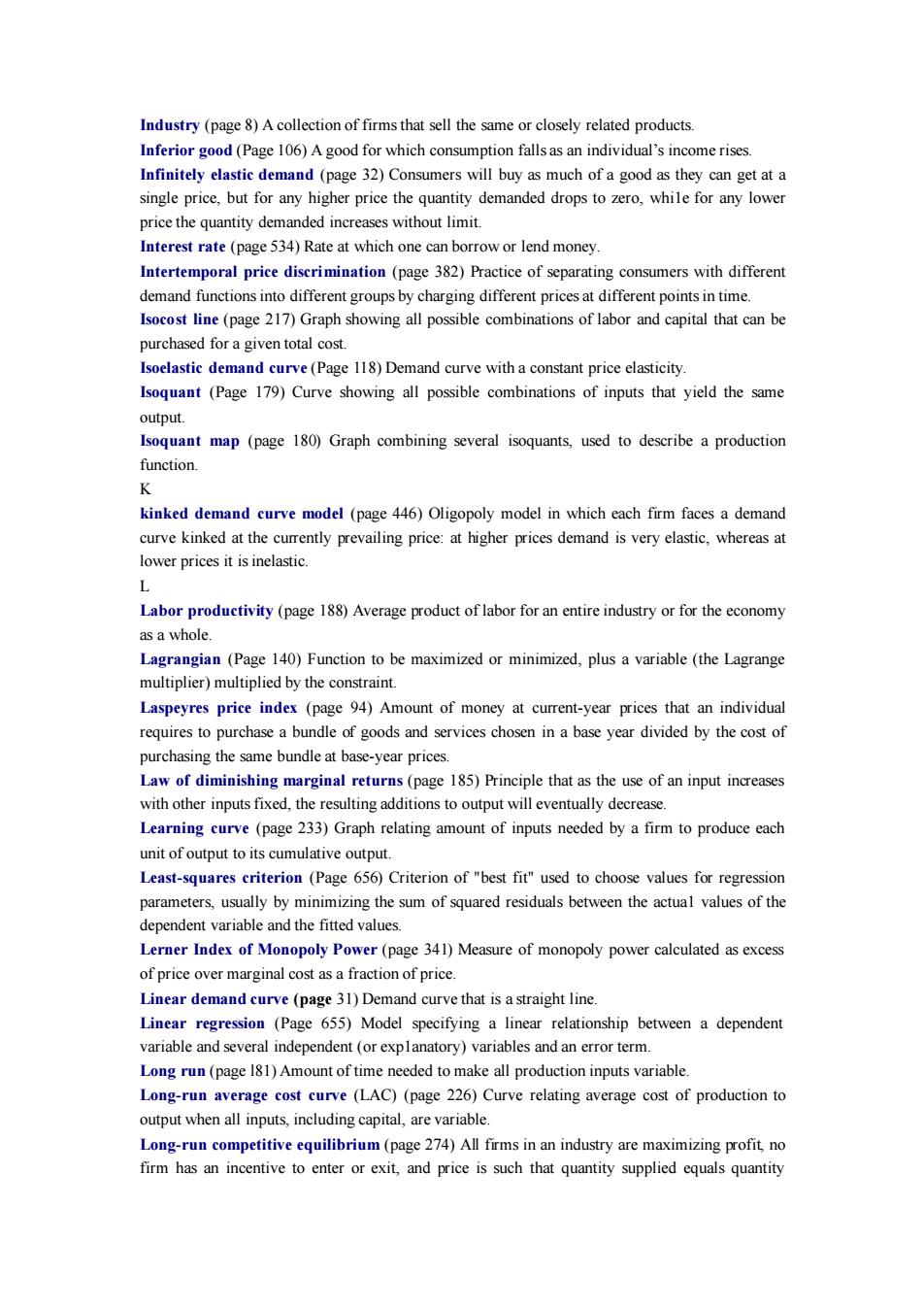正在加载图片...

Industry (page 8)Acollection of firms that sell the same or closely related products. Infinitely elastie demand (page 32)Consumers will buy as much of a good as they can get at a single price,but for any higher price the quantity demanded drops to zero,while for any lower price the quantity demanded increases without limit. Interest rate (page 534)Rate at which one can borrow or lend money demand different groupsby charging different pricesat different points intime Isoeost line(page 217)Graph showing all possible combinations of labor and capital that can be ourchased for a given total cost. Isoelastic demand curve(Page 118)Demand curve with a constant price elasticity. soquant(Page 179)Curve showing all possible combinations of inputs that yield the same output Isoquant map (page 180)Graph combining several isoquants,used to describe a productior function. K kinked demand curve model (page 446)Oligopoly model in which each firm faces a demand curve kinked at th rently prevailing price at higher prices demand is very elastic whereas at ower prices itisinelasti Labor productivity (page 188)Average product of labor for an entire industry or for the economy as a whole. Lagrangian (Page 140)Function to be maximized or minimized,plus a variable(the Lagrang Laspeyres price index (page 94)Amount of money at current-year prices that an individua requires to purchase a bundle of goods and services chosen in a base year divided by the cost of purchasing the same bundle at base-vear prices. aw of diminishing marginal ret rs(page 185)Principle that as the use of an input increases with othe rinputs fix resulting itions toouput will event Learning curve (page 233)Graph relating amount of inputs needed by a firm to produce each unit of output to its cumulative output Least-squares criterion (Page 656)Criterion of "best fit"used to choose values for regression parameters,usually by minimizing the sum of squared residuals between the actual values of the dependent variable d the fitted values opoly Power(page 341)Measure of monopoly power calculated as excess of price over marginal cost as a fraction of price. Linear demand curve (page 31)Demand curve that is a straight line. Linear regression (Page 655)Model specifving a linear relationship between a dependent variableand several independent (o expanatory)variables ng(page )Amout of tme needed to make all produ Long-run average cost curve (LAC)(page 226)Curve relating average cost of production to output when all inputs.including capital.are variable Long-run competitive equilibrium (page 274)All firms in an industry are maximizing profit no firm has an incentive to enter or exit,and price is such that quantity supplied equals quantityIndustry (page 8) A collection of firms that sell the same or closely related products. Inferior good (Page 106) A good for which consumption falls as an individual’s income rises. Infinitely elastic demand (page 32) Consumers will buy as much of a good as they can get at a single price, but for any higher price the quantity demanded drops to zero, whi1e for any lower price the quantity demanded increases without limit. Interest rate (page 534) Rate at which one can borrow or lend money. Intertemporal price discrimination (page 382) Practice of separating consumers with different demand functions into different groups by charging different prices at different points in time. Isocost line (page 217) Graph showing all possible combinations of labor and capital that can be purchased for a given total cost. Isoelastic demand curve (Page 118) Demand curve with a constant price elasticity. Isoquant (Page 179) Curve showing all possible combinations of inputs that yield the same output. Isoquant map (page 180) Graph combining several isoquants, used to describe a production function. K kinked demand curve model (page 446) Oligopoly model in which each firm faces a demand curve kinked at the currently prevailing price: at higher prices demand is very elastic, whereas at lower prices it is inelastic. L Labor productivity (page 188) Average product of labor for an entire industry or for the economy as a whole. Lagrangian (Page 140) Function to be maximized or minimized, plus a variable (the Lagrange multiplier) multiplied by the constraint. Laspeyres price index (page 94) Amount of money at current-year prices that an individual requires to purchase a bundle of goods and services chosen in a base year divided by the cost of purchasing the same bundle at base-year prices. Law of diminishing marginal returns (page 185) Principle that as the use of an input increases with other inputs fixed, the resulting additions to output will eventually decrease. Learning curve (page 233) Graph relating amount of inputs needed by a firm to produce each unit of output to its cumulative output. Least-squares criterion (Page 656) Criterion of "best fit" used to choose values for regression parameters, usually by minimizing the sum of squared residuals between the actua1 values of the dependent variable and the fitted values. Lerner Index of Monopoly Power (page 341) Measure of monopoly power calculated as excess of price over marginal cost as a fraction of price. Linear demand curve (page 31) Demand curve that is a straight line. Linear regression (Page 655) Model specifying a linear relationship between a dependent variable and several independent (or exp1anatory) variables and an error term. Long run (page l81) Amount of time needed to make all production inputs variable. Long-run average cost curve (LAC) (page 226) Curve relating average cost of production to output when all inputs, including capital, are variable. Long-run competitive equilibrium (page 274) All firms in an industry are maximizing profit, no firm has an incentive to enter or exit, and price is such that quantity supplied equals quantity